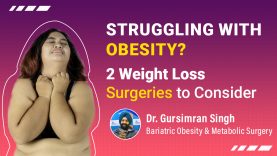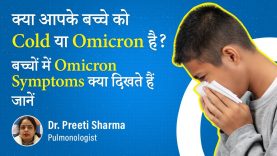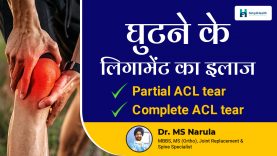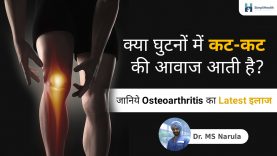Osteoarthritis Treatment & Symptoms | ऑस्टियोआर्थराइटिस का मुख्य कारण क्या है?
- 1.68K
- 3 years ago
Dr. Manpal Singh Narula
Dr. Manpal Singh Narula
Osteoarthritis Treatment & Symptoms | ऑस्टियोआर्थराइटिस किसकी कमी से होता है? व कैसे ठीक होता है?
Osteoarthritis treatment & symptoms, In this video SimpliHealth Orthopaedics, Joint Replacement & Spine Specialist Dr. MS Narula is talking about Osteoarthritis(ऑस्टियोआर्थराइटिस) and its Symptoms, Causes, Risk & Treatment. Also he is answering some questions that people usually ask like:
- Who is most at risk for osteoarthritis?
- What is osteoarthritis and what type of joints does it affect?
- Exercises for Knee Osteoarthritis and Joint
It is an age-related degenerative disease. Primary osteoarthritis should be differentiated from secondary osteoarthritis. Primary is the wear and tear caused due to growing age. And secondary osteoarthritis is because of some injury, trauma or it could be because of some disease. So these have to be differentiated. Like there is inflammatory arthritis, Which we call Rheumatoid Arthritis, which is not osteoarthritis. So today, we will only talk about osteoarthritis.
Who is most at risk for osteoarthritis? | Osteoarthritis Treatment & Symptoms
Our expert compares it to the graying of hair or needing specs. Everyone after a particular age is predisposed to osteoarthritis. Usually, we used to see this disease after 50-55. But nowadays we see it in people above the age of 40-45.
This could happen because of multiple reasons—lack of exercise. Obesity, being overweight, is the single most important risk factor of osteoarthritis. Then it can be seen in people who do not eat healthily and in people who don’t do any physical activity. If you have any osteoarthritis history in your family, you are predisposed to osteoarthritis. These were the risk factors of osteoarthritis of the knee.
What are the signs and symptoms of osteoarthritis?
People in their 40s or 50s complain that they find it difficult to get up from a low sitting position. This is the first sign of osteoarthritis. Later on, climbing the stairs, especially coming down, is painful. And then the walking starts to become painful. After that, the patient could walk longer miles without knee pain. In the next stage, resting pain also starts. Your knees may hurt even if you are just sitting and doing nothing.
So these are the various stages of osteoarthritis, depending on the level of degeneration. So what is osteoarthritis? Like I said it is an age-related degeneration. A normal knee joint looks like this. It has these two bones and cartilage in between them and a lining. This together forms a complete knee joint.
With age, the cartilage starts to wear out. The joint fluid decreases. And the lining starts to erode. In simple terms, the joint starts to rub, and the fluid reduces.
Patients often hear from someone that their knee ran out of grease. And he doesn’t like to use the term ‘grease depletion.’ Because when earlier we used to tell the patient this, they used to go home and start eating greasy food and oils. Which resulted in weight gain and worsened the condition. So this is not the grease. It is a natural joint fluid that starts to reduce.
What is osteoarthritis and what type of joints does it affect?
The most common joint that we see of osteoarthritis is the knees. Because we are used to sitting cross-legged on the floor, sitting on an Indian toilet, and of course, there’s obesity. The knee is the most common joint as it is a weight-bearing joint.
And there are also cases of osteoarthritis of the hip and a few cases of osteoarthritis of the shoulder and hand. But the knee followed by the hips is the common joint that is affected by osteoarthritis in an obese patient.
What are the Osteoarthritis Treatments? | Osteoarthritis Treatment & Symptoms
Early-stage
When you go to an orthopedic doctor, they first take an X-ray. And in that X-ray, we see the gap between the bones lessen. The cartilage is seen as a gap in the x-ray, and we can see the bones coming closer together. The inner part of the joint comes closer, and therefore the patients always complain about pain in the inner part of the joint. Later there comes a stage where the bones come so close that they start to rub against each other. And as there is no gap now, we can see a bowing of the knee in the elderly. And it also starts to hurt.
So there are different treatment options depending on what stage the osteoarthritis is.
In the early stage, weight reduction is a very important part. There is a certain factor that we cannot control, like age. So controlling our body weight is the only option we have. The wear and tear cannot be stopped or reversed. But it can be slowed down. The thing which will take 2 years to deteriorate, we can delay it for 5 or 10years.
After weight reduction, the other thing is physical exercise. There are muscle exercises for the knees that we suggest to the patient. There are certain do’s and don’ts to this.
Don’ts:
One should avoid sitting cross-legged on the floor, switch to western toilets, avoid standing for long hours. Prolonged standing worsens the knee. So all these things should be avoided as they may worsen the pain.
Do’s:
Appropriate weight loss knee exercises can help improve the pain and delay the degeneration process. So at the early stage, we suggest weight loss, exercises, and prescribed cartilage supplements and pain killers.
Middle-stage
When osteoarthritis reaches the next stage. Where these conservative treatments don’t work, and the patient’s pain keeps increasing. We resort to injections, which can be synthetic as well as natural. This helps lubricate the joints. This can delay the problem for 1-2 years. But this treatment method is for the in-between stage, not too early, not too late.
Late-stage
The late-stage is when there is no gap between the bones, and they are rubbing against each other. In this case, we opt for a very safe, bloodless, painless surgery. As you must be aware, total knee replacement surgery is very safe and very effective.
When to get this surgery?
If you have:
- A severe knee damage,
- Are above the age of 50-55,
- Your X-ray shows that your bones are rubbing into each other,
- You have to have a painkiller each morning
The patient asks me when to get this surgery. My answer is very simple. This surgery is for your quality of life. If your knee doesn’t allow you to do your normal chores, or you have trouble walking, and you have to take a painkiller daily and if your pain is unbearable, then you must consult your orthopedic doctor about this.
If he examines your X-rays and sees that your knee is in bad condition, it could be 50 years or 65 years, and then he would suggest knee replacement surgery accordingly. Go to a good, experienced surgeon and get it done in good time. We would consider the surgery a success if the patient comes to us walking and pain-free.
High motion resurfacing
Our expert would Like to tell the patients about the new technique and better implants called High motion resurfacing. Instead of replacing the entire joint, they just change the topmost layer. The patient can walk the next day after the surgery. On the fifth day, the patient can walk home. But we stress not waiting this long for the knee to get to this point. And they don’t suggest not getting the surgery done. If they get the surgery done at the right time, there is very less bone cutting required. And it ensures faster recovery.
Exercises for Knee Osteoarthritis and Joint
A lot of patients ask me which exercise, yoga, or cycling is better for our knee osteoarthritis. Any exercise that requires being the knee too much, like Padmasana and Vajrayana, should be avoided. The rest of the yoga exercises that do not require bending the knee so much are very helpful. Cycling is a very good exercise for you. Swimming is very good. You can walk depending on how much pain you are in. Running, skipping, and jumping should be avoided. Like he mentioned before, prolonged standing should be avoided. Cycling is the best, the muscles would become stronger, and it won’t put too much pressure on the knee.















Comments (1)